Rhomboid Muscles: Exercises for Strength and Flexibility

The rhomboid muscles are located between the lower part of the neck and the upper region of the thorax. In this article, we’ll tell you everything you need to know about them, including exercises to strengthen and stretch them.
You might like: Heavyweights Training: Strengthen Muscles in a Short Time?
What are rhomboid muscles?
The rhomboid muscles are underneath the trapezoid muscles, located in the back. More precisely, they run from the spine to the spinal end of the scapula.
In very thin or muscular people, you can see the rhomboid through the skin, inside the infraspinatus relief. The rhomboid muscles are divided into two large groups:
1. Rhomboid minor muscles
These are located in the lower part of the neck ligament, between the seventh cervical vertebra and the first thoracic vertebra. The rhomboid minor muscles are inserted at the edges of the vertebrae, near to where the spine meets the scapula.
2. Rhomboid major muscles
These are located in the bony apophyses of the thoracic vertebrae and the supraspinatus ligament. They are inserted at the edge of the scapulae. The rhomboid major muscles are superficial and are located below the trapezoid muscles and the rhomboid minor muscles. They’re shaped like a diamond (hence their name).
The main objective of the rhomboid muscles is to keep the scapula and arms rigid, but they also come into action by retracting the scapula, as they ‘pull’ it towards the spine. As if that weren’t enough, they connect the scapula with the chest wall.
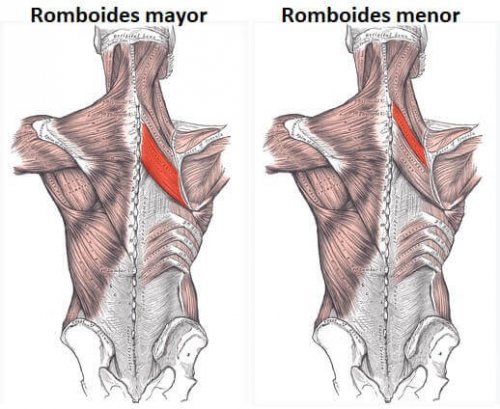
Exercises to work the rhomboid muscles
Now that you know what the rhomboid muscles are, the next step is to work to strengthen and stretch them. This way, you’ll avoid common spinal and back pain. In addition, you’ll also tone and define the area if that is your intention. Pay attention to the best exercises for this region of the back:
1. Reverse fly
This exercise allows you to work both the rhomboid muscles and the trapezoid muscles. Additionally, it can be done standing, sitting or with a cable machine.
For the latter, choose the appropriate weight and sit facing the machine. Leave the fixed cables at shoulder height. Take a cable handle in each hand with your palms facing each other. Don’t forget to keep your back straight during the entire exercise.
Now, pull the cables horizontally to the sides, with your arms extended and your elbows slightly bent. Return to the starting position slowly and do 10 repetitions.
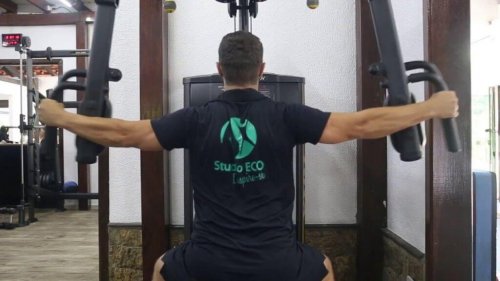
2. Inclined pull-ups
This exercise is also known as an inverted row or Australian pull up and uses the body’s own weight to reinforce the rhomboid muscles, along with other back and shoulder muscles. You need a low horizontal bar, such as those found in parks with sports circuits.
Take the bar with your hands shoulder-width apart. Get underneath the bar so it’s at chest level. Your body must be diagonal to the ground and your gaze should always be up.
Perform the pull-ups by stretching out and bending the arms, always slowly and paying close attention to your posture and technique. Inhale when extending and exhale when flexing. Do between 8 and 10 repetitions.
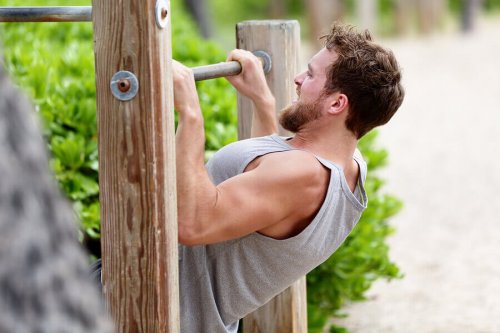
3. Side elevations sitting
To perform this exercise, you’ll need two dumbbells or weight discs of your choice. Sit on a bench and keep your back supported and straight at all times. Keep your legs slightly apart.
Take a dumbbell in each hand and place your arms at your sides, then raise both your arms at the same time without bending them until they’re at shoulder height (parallel to the ground). Hold this position for a few seconds and then slowly lower. Do 10 repetitions.
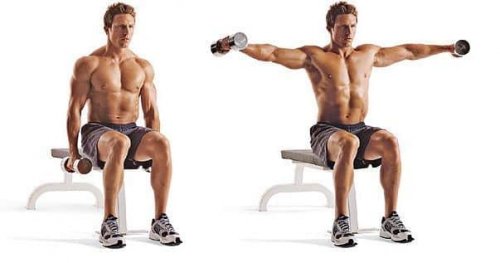
4. Posterior capsule stretch
With this special exercise, you’ll be able to stretch the rhomboid muscles in a way that also has positive effects on the surrounding connective tissues and on the shoulder rotator cuffs. It relaxes muscles, relieves inflammation after training, and reduces fatigue due to poor posture or over-training.
To do this, stand up and bring your left arm in front of your chest, stretched all the way out. Exert some pressure using the right hand, at the level of the elbow. Hold for 10 seconds and change sides. To make the stretching more effective, we recommend you take deep breaths while doing it.
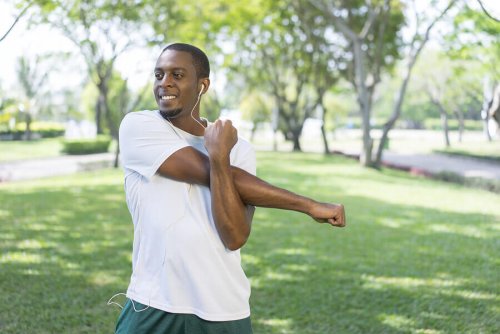
In conclusion, we’ve verified that the rhomboid muscles are very important and exercising them is relatively simple. So, don’t stop working them out and stretching them after exercise!
The rhomboid muscles are located between the lower part of the neck and the upper region of the thorax. In this article, we’ll tell you everything you need to know about them, including exercises to strengthen and stretch them.
You might like: Heavyweights Training: Strengthen Muscles in a Short Time?
What are rhomboid muscles?
The rhomboid muscles are underneath the trapezoid muscles, located in the back. More precisely, they run from the spine to the spinal end of the scapula.
In very thin or muscular people, you can see the rhomboid through the skin, inside the infraspinatus relief. The rhomboid muscles are divided into two large groups:
1. Rhomboid minor muscles
These are located in the lower part of the neck ligament, between the seventh cervical vertebra and the first thoracic vertebra. The rhomboid minor muscles are inserted at the edges of the vertebrae, near to where the spine meets the scapula.
2. Rhomboid major muscles
These are located in the bony apophyses of the thoracic vertebrae and the supraspinatus ligament. They are inserted at the edge of the scapulae. The rhomboid major muscles are superficial and are located below the trapezoid muscles and the rhomboid minor muscles. They’re shaped like a diamond (hence their name).
The main objective of the rhomboid muscles is to keep the scapula and arms rigid, but they also come into action by retracting the scapula, as they ‘pull’ it towards the spine. As if that weren’t enough, they connect the scapula with the chest wall.

Exercises to work the rhomboid muscles
Now that you know what the rhomboid muscles are, the next step is to work to strengthen and stretch them. This way, you’ll avoid common spinal and back pain. In addition, you’ll also tone and define the area if that is your intention. Pay attention to the best exercises for this region of the back:
1. Reverse fly
This exercise allows you to work both the rhomboid muscles and the trapezoid muscles. Additionally, it can be done standing, sitting or with a cable machine.
For the latter, choose the appropriate weight and sit facing the machine. Leave the fixed cables at shoulder height. Take a cable handle in each hand with your palms facing each other. Don’t forget to keep your back straight during the entire exercise.
Now, pull the cables horizontally to the sides, with your arms extended and your elbows slightly bent. Return to the starting position slowly and do 10 repetitions.

2. Inclined pull-ups
This exercise is also known as an inverted row or Australian pull up and uses the body’s own weight to reinforce the rhomboid muscles, along with other back and shoulder muscles. You need a low horizontal bar, such as those found in parks with sports circuits.
Take the bar with your hands shoulder-width apart. Get underneath the bar so it’s at chest level. Your body must be diagonal to the ground and your gaze should always be up.
Perform the pull-ups by stretching out and bending the arms, always slowly and paying close attention to your posture and technique. Inhale when extending and exhale when flexing. Do between 8 and 10 repetitions.

3. Side elevations sitting
To perform this exercise, you’ll need two dumbbells or weight discs of your choice. Sit on a bench and keep your back supported and straight at all times. Keep your legs slightly apart.
Take a dumbbell in each hand and place your arms at your sides, then raise both your arms at the same time without bending them until they’re at shoulder height (parallel to the ground). Hold this position for a few seconds and then slowly lower. Do 10 repetitions.

4. Posterior capsule stretch
With this special exercise, you’ll be able to stretch the rhomboid muscles in a way that also has positive effects on the surrounding connective tissues and on the shoulder rotator cuffs. It relaxes muscles, relieves inflammation after training, and reduces fatigue due to poor posture or over-training.
To do this, stand up and bring your left arm in front of your chest, stretched all the way out. Exert some pressure using the right hand, at the level of the elbow. Hold for 10 seconds and change sides. To make the stretching more effective, we recommend you take deep breaths while doing it.

In conclusion, we’ve verified that the rhomboid muscles are very important and exercising them is relatively simple. So, don’t stop working them out and stretching them after exercise!
All cited sources were thoroughly reviewed by our team to ensure their quality, reliability, currency, and validity. The bibliography of this article was considered reliable and of academic or scientific accuracy.
- Lisón, J. F., Monfort, M., & Sarti, M. A. (1998). Entrenamiento isométrico de la musculatura lumbar. Actas Del VI Congreso Galego de Educación Física.
This text is provided for informational purposes only and does not replace consultation with a professional. If in doubt, consult your specialist.








